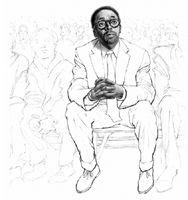Decoded (40 page)
Authors: Jay-Z
Tags: #Rap & Hip Hop, #Rap musicians, #Rap musicians - United States, #Cultural Heritage, #Jay-Z, #Entertainment & Performing Arts, #United States, #Music, #Rich & Famous, #Biography & Autobiography, #Genres & Styles, #Composers & Musicians, #Biography

14.
In the end, I bring it back to music—and to the actual relationship between me and Bleek.
D’EVILS
1.
“Coming of Age” and “D’Evils” are two songs on the same basic theme. They’re both about being in the game and they both deal with competition and friendship. But the “Coming of Age” songs are about a boss dealing with the rise of someone younger, while “D’Evils” is about the relationship between peers, two people who grew up together.
2.
The “mechanics” here aren’t about the technical details of the business, but the psychological and emotional machinery that’s always working under the surface.
3.
The first defense of a lot of people who take the criminal route is that they had no choice, which is almost true: Most of us had choices, but the choices were bleak. The street life was tough and morally compromised and sometimes ugly, but a dead-end nine-to-five job at permanent entry level wasn’t all that attractive, either. The righteous seed in a hustler’s mentality was this: He wanted something more for himself.
4.
This reflects the way I actually thought: I ignored my god-given ability, never believing that someone from where I came from could make it out.
5.
The whole idea of “D’Evils” is that the narrator is no longer just expressing his ambition to live a full life—he’s been poisoned somehow, possessed with a desire for money, alienated from all that’s good, and focused on the underworld, here represented by Mafia references.
6.
The narrator isn’t thinking about redemption or turning back—he’s totally focused on making money, “ends.”
7.
“D’Evils”—this obsession with getting paid—is something the narrator picks up after he “breaks bread with the late heads,” who school him in ruthlessness.

8.
I’m describing childhood friends, who went from fighting for those blocks with ABCs on them to fighting to control buildings where they can move crack and “make a killing.”
9.
Here’s where the song takes a sudden turn from a general analysis and reminiscences to a clear narrative. I tried to convey a lot of information in one line: that we were friends so close that we learned basic sex ed at the same time; that he “never learned,” which sets him up as someone sloppier, less calculating and cunning than me; that he had a child as a result, and “a baby’s mother”; and that I kidnapped her, which shows how profoundly “blackhearted” I had become, violently exploiting any opening—even the innocent mother of his child. The line goes from the innocence of two dumb kids learning to use condoms together, bypasses any happiness or joy about the birth of a child, and ends in a truly dark place. It’s the poison of “D’Evils” sketched out in a few words.
10.
The “cheese” is money, which I’m feeding her to try to get her to rat out the location of her man.
11.
Extending the money-as-food metaphor, I keep feeding her larger bills till she shits out some information, the dollars breaking down to cents/sense as she digests them.
12.
This reflects another movement from innocence to violence, from slumber parties to putting her to sleep forever.
13.
In the end, I get her to do what I want, but it’s a grim victory. Not only will blood be shed based on the information she’s given me—hers and his—but the last vision of her, tears like a veil over her eyes, begging for both of their lives, is going to haunt me. Her miseries become mine.
14.
Another quick scene: Possessed by material lust, the narrator sticks up random people. The quick line of dialogue is meant to show someone completely blinded by desire, reckless and aggressive, but also haunted, the kind of character who talks to his vics as he’s robbing them, making jokes and justifying himself by saying the whole world has done him wrong, so now everyone owes him. This could be the same character from the opening verses; driven over the edge by the killing of his best childhood friend, now he’s just a raging psychopath.
15.
The song ends with a dizzying carousel of conversations: First the narrator addresses his mother, then his girl (“boo”), and finally a last victim. The narrator is completely lost to the “D’Evils.” He taunts his victims, defends himself, brags about how low he gets down, invites niggas to try to come get him, like George Bush saying “bring ’em on” to the terrorists. The final two lines, contrasting the demons in his head with a God he thinks is powerless, show how deeply he’s fallen into a moral vacuum. The song isn’t about literal demonic possession, of course, even if some sloppy listeners claim that it is; the truth is you don’t need some external demon to take control of you to turn you into a raging, money-obsessed sociopath, you only need to let loose the demons you already have inside of you.
99 PROBLEMS (VERSE 2)
1.
This is based on a true story, but ultimately it’s fictional. Our hero here is riding dirty, road-tripping down the turnpike from somewhere farther north, which is how things worked back in the eighties and early nineties. New York guys had better connects and opened up drug markets down the I-95 corridor. It was one of the factors that made coke money so thick in New York during that period, and the competition turned the game bloody from Brooklyn to Baltimore to D.C. to the Carolinas.
2.
The car might’ve been a Maxima, which were big on the streets in ’94. In the real-life version of this story, the trunk wasn’t raw, it was a compartment in the sunroof that doubled as a “stash.”

3.
Jake is one of a million words for the boys in blue, but it’s particularly dismissive and used mostly in New York, so it works as a way of establishing the character of the narrator. He’s a slick New York kid.
4.
“Driving while black” was usually a sufficient reason for the police to stop us. The first offense wasn’t the crack in the ride but the color of the driver.
5.
When we did work out of state, we would have everything planned down to the finest detail—but then get caught by a cop for no good reason, like “driving fifty-five in a fifty-four.” Of course, the sarcasm in the speed limit being fifty-four is another way of saying that we’re being pulled over for no good reason.
6.
“A lot of you are” is another statement with racial undertones that he and I are both aware of.
7.
This dialogue is about the tension between a cop who knows that
legally
he’s dead wrong for stopping someone with no probable cause other than race, and a narrator who knows that legally he’s dead wrong for moving the crack. But legality aside, they both think they’re justified—and the fact is they’re both used to getting away with it. So they’re playing this cat-and-mouse game, taking sarcastic shots at each other, arguing over the law. The confrontation is casual and consequential all at once and shows how slippery language is, depending on which side of the conversation you’re on.
8.
In every verse of the song I use the word “bitch” in a different way. In this verse, the bitch is a female dog, the K-9 cop coming to sniff the ride. When I was living my version of this story, we got away—the K-9 was late, and the cop let me go. We were back on the road again, hearts pounding, crack still tucked untouched in the stash, when I saw the K-9 unit screaming up the highway, going in the opposite direction. It would’ve changed my life if that dog had been a few seconds faster. We had a strange kind of luck, some kind of rogue angel watching over us. But in the song I left the outcome ambiguous—does he get away or not? That’s the writer in me. I like ambiguous endings, like Shane staggering off into the sunset at the end of the movie. Does he die or does he live? And the larger question: Should he die or live? I leave it to the listener to decide.

IGNORANT SHIT / FEATURING BEANIE SIGEL
1.
This is a slight exaggeration.
2.
In the opening four lines of the song, I made sure to include the big four “ignorant” subjects: chicks taking off their clothes, guns popping, drugs getting sold, and spending money. The rest of the song follows from there.
3.
The first block is a block of coke; the second is the actual city block.
4.
The television show
CHiPs
ran from 1977 to 1983. Truthfully, I wasn’t doing this since I was eight, but close.
5.
There are a lot of motel references in my songs. Motels are where a lot of our work got done, where we bagged our powder.
6.
In Spike Lee’s movie, the 25th hour was the moment right before the main character went to prison. Every hour is the 25th hour when you’re on the streets; it can end at any moment.
7.
“Spike Lees” are slang for the best seats in the house—in this case, whether it’s at the arena or in the jet.

Other books
The Mothman Prophecies by John A. Keel
4 on the Floor by B.J. Scott
Save Me by Eliza Freed
Bed & Breakfast Bedlam (A Logan Dickerson Cozy Mystery Book 1) by Abby L Vandiver
A Darker Place by Laurie R. King
Talking to Dragons by Patricia C. Wrede
A Family Business by Ken Englade
Exile in the Water Kingdom (The Elemental Phases Book 3) by Cassandra Gannon
Elves and Escapades (Scholars and Sorcery Book 2) by Eleanor Beresford
Walking on Sunshine: A Sweet Love Story (Seasons of Love Book 1) by Lakes, Krista, York, Darla
